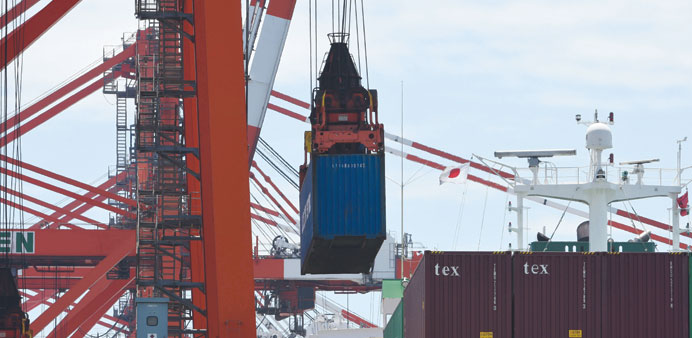Cranes load containers on a cargo ship at a pier in Tokyo. When the BoJ’s nine-member policy-setting board meets on August 7-8, whether exports recover in the July-September quarter will likely be an issue of debate, sources said yesterday.
Dow Jones
Bank of Japan officials are becoming less confident in their outlook on exports after having erred on the side of optimism for more than a year, setting the stage for fresh debate at their policy meeting next week.
The central bank’s assessment of exports warrants close attention, especially as Japanese households have been slow to open their wallets in the face of a higher tax burden. If exports stay listless or deteriorate further, forcing the central bank to admit the failure to revive threatens to derail its rosy outlook on growth and prices, the central bank could come under renewed pressure to add to its already massive stimulus measures.
Japanese exports fell for a second straight quarter in the three months through June, according to recent data. That again disappointed the BoJ, which has insisted since adopting the current aggressive easing measures in April last year that exports would soon recover.
When the BoJ’s nine-member policy-setting board meets on August 7-8, whether exports recover in the July-September quarter “will likely be an issue of debate,” people familiar with the central bank’s thinking said. The BoJ is widely expected to keep monetary policy on hold at the meeting.
In addition to the outlook for exports, the board members, led by Governor Haruhiko Kuroda, may discuss whether to tone down language currently used to describe the state of exports, the people said. In its July assessment of Japan’s economy, the board said exports “have recently levelled off, more or less.” The central bank last lowered its view of exports in March.
Whether the board will change the wording isn’t clear yet, the people said, with the decision partly depending on other factors, such as industrial output data due tomorrow. Economists look at industrial output data in measuring the strength of overseas demand for Japan-made goods. Some officials may also prefer to wait until July-September data are available, the people said.
The BoJ’s confidence in meeting its pledge to achieve 2% inflation by next year is rooted in its belief that business and government spending will keep the economy going until consumption rebounds – even if exports remain subdued. Meanwhile, a tighter domestic labour market, reduced slack in the economy, and growing income across the labour force should underpin inflationary pressure.
But the failure of exports to rebound could eventually discourage manufactures from investing, possibly affecting growth in jobs and wages. Exports accounted for 17% of Japan’s economic production in the January-March period. Merchandise exports fell about 1% in price-adjusted terms in the April-June quarter from the previous three months, about the same rate as in the January-March period, according to BoJ data.
Bank of Japan officials now strongly suspect they have underestimated the impact of years of efforts by Japanese firms to shift supply chains overseas to reduce exchange-rate risks and take advantage of higher demand abroad, the people said. Manufacturers increasingly produce and sell in their foreign markets – something that has fuelled concerns in Japan about industrial hollowing-out.
Other possible culprits identified by the BoJ include weakening competitiveness of Japanese manufacturers, subdued Asian demand, sluggish global business investment, and the lingering impact of an unusually cold winter in the US.



